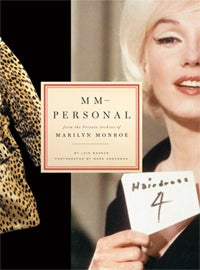Marilyn Monroe: A New Interpretation Through Words and Photos
Leaving Los Angeles and driving through a string of towns in 2007, Lois Banner arrived at an unassuming house nestled in a quiet neighborhood of Rowland Heights. There she met photographer Mark Anderson.
Anderson had come across Banner’s expert citations on legendary blond bombshell Marilyn Monroe in the LA Weekly. He called Banner and asked her if she wanted to collaborate with him on a picture book that he was working on. She was thrilled.
Banner, professor of history and gender studies in the USC Dana and David Dornsife College of Letters, Arts and Sciences, is fascinated with visual culture and enjoyed working with Anderson who she describes as a brilliant photographer. The book is filled with exquisite collages of Marilyn’s possessions, all selected by Banner, and artfully displayed in thoughtful composition. The book, MM — Personal, was aptly titled after one of the hundreds of files in the cabinets.
Published this month by Abrams, the book is based on two “found” tall metal cabinets, one beige and one gray — the latter equipped with a locked vault — referred to as the “Marilyn Collection” and containing a trove of treasures belonging to Monroe. Banner estimates that five to ten thousand items were hidden away in these cabinets, including telegrams, receipts, photos, handwritten and typed personal and business correspondence, legal documents, clothing inventory and financial records, to name a few.

MM — Personal, published by Abrams, written by USC Dornsife’s Lois Banner.
Both generous and a spendthrift, Monroe had been instructed by her accountant to keep all of her receipts.
“This book represents a new interpretation of Marilyn,” Banner said. “I tried to keep the book focused on the photos and the material in the file cabinets, but they do present a different view of Marilyn.”
Banner was given a thousand photographs in no particular order with titles that often bore no relationship to them. She organized the photos, and wrote captions, chapter introductions and the book’s introduction.
Banner purposely chose not to organize the photos chronologically. “I thought it would be more interesting to arrange them by areas in her life,” she said, “that is how we think of lives in terms of categories of behaviors and activities, not just day to day events.”
The only part of the book that is composed chronologically are the last two years of her life when, according to Banner, Monroe’s life was falling apart. “This period stands by itself,” she said. To help the reader piece together the timeline of Monroe’s life, a date list appears in the back of the book.
To understand the highly complex Monroe, Banner said that you have to understand her complexities. “She had many personas, not just one, and she moved in and out of them.”
There are three main takeaways that Banner hopes to leave with the reader: Marilyn could cook, clean, get along with children, and wrote very well; she had every woman’s dilemma balancing work and home; and she was not the loner the tabloids would have you believe.
Through the receipts and letters, Banner reveals glimpses of Monroe’s personality and life. “She wrote notes to herself at night that gave her an opportunity to think through thoughts to herself.”
Banner did not publish all the letters that she came across. “Marilyn fought patriarchal men in Hollywood and these letters were difficult to decipher — an intricate maze of dealings with heads of studios, chess games with lawyers, and producers who blocked a creative artist’s ability to put herself in good films.”
Included in the found photographs are pictures taken by Marilyn, which are fairly rare. “There are some wonderful photographs of her third husband, playwright Arthur Miller’s children and friends in Amagansett, New York.”
Banner was delightfully stunned by the beauty of Monroe’s letters to Miller’s children. “Marilyn wrote a gorgeous letter to his children as if it was authored by Hugo, the adored family dog.”
A perfectionist at heart, Monroe while married to Miller, wrote to the editor of the Ladies’ Home Journal, Mary Bass, thanking her for bouillabaisse and beef burgundy recipes.
A good many receipts came from drugstores, clothing stores and beauty salons. “Marilyn was always having facials and was concerned with maintaining her glowing translucent skin.”
Among the receipts was one showing a purchase of a diary from a New York stationery shop —the long-reported missing red diary? This and more will be the subject of Banner’s current work in progress that she hopes to publish in 2012, the 50th anniversary year of Monroe’s death.
Banner will discuss her book at the upcoming Los Angeles Times Festival of Books at USC (events.latimes.com/festivalofbooks/). She is an invited speaker at the Friends of the USC Libraries Literary Luncheon (web-app.usc.edu/ws/eo2/calendar/32/event/893108).